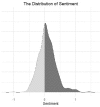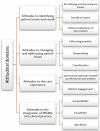What are the attitudes of health professionals regarding patient reported outcome measures (PROMs) in oncology practice? A mixed-method synthesis of the qualitative evidence
- PMID: 32041593
- PMCID: PMC7011235
- DOI: 10.1186/s12913-020-4939-7
What are the attitudes of health professionals regarding patient reported outcome measures (PROMs) in oncology practice? A mixed-method synthesis of the qualitative evidence
Abstract
Background: The adoption of Patient Reported Outcome Measures (PROMs) in cancer care has been widely advocated, but little is known about the evidence for the implementation of PROMs in practice. Qualitative research captures the perspectives of health professionals as end-users of PROMs and can be used to inform adoption efforts. This paper presents a systematic review and synthesis of qualitative research conducted to address the question: What are the attitudes of health professionals towards PROMs in oncology, including any barriers and facilitators to the adoption of PROMS, reported in qualitative evidence?
Methods: Systematic searches of qualitative evidence were undertaken in four databases and reviewed using the Preferred Reporting Items for Systematic Reviews and Meta-Analyses guidelines. Studies published in English between 1998 and 2018, which reported qualitative findings about the attitudes of health professionals working in oncology towards PROMs were eligible. Studies were assessed using the Critical Appraisal Skills Programme's Qualitative Research Checklist. A sentiment analysis was conducted on primary text to examine the polarity (neutral, positive or negative) of health professionals' views of PROMs. Qualitative meta-synthesis was conducted using a constant comparative analysis.
Results: From 1227 articles after duplicates were removed, with 1014 excluded against the screening criteria, 213 full text articles remained and were assessed; 34 studies met the inclusion criteria and were included. The majority of studies were of good quality. Sentiment analysis on primary text demonstrated an overall positive polarity from the expressed opinions of health professionals. The meta-synthesis showed health professionals' attitudes in four domains: identifying patient issues and needs using PROMs; managing and addressing patient issues; the care experience; and the integration of PROMs into clinical practice.
Conclusions: From the accounts of health professionals, the fit of PROMs with existing practice, how PROMs are valued, capacity to respond to PROMs and the supports in place, formed the key factors which may impede or promote adoption of PROMs in routine practice. To assist policy-makers and services involved in implementing these initiatives, further evidence is required about the relationship between PROMs data collection and corresponding clinical actions.
Trial registration: International Prospective Register of Systematic Reviews (PROSPERO) CRD42019119447, 6th March, 2019.
Keywords: Health professional attitudes; Implementing practice change; Oncology; PROMs; Patient reported outcome measures; Qualitative synthesis.
Conflict of interest statement
The authors declare that they have no competing interests.
Figures
References
-
- Williams K, Sansoni J, Morris D, Grootemaat P, Thompson CJ. Patient-reported outcome measures: literature review. Sydney: Australian Health Services Research Institute, University of Wollongong; 2016.
Publication types
MeSH terms
Grants and funding
LinkOut - more resources
Full Text Sources
Miscellaneous




